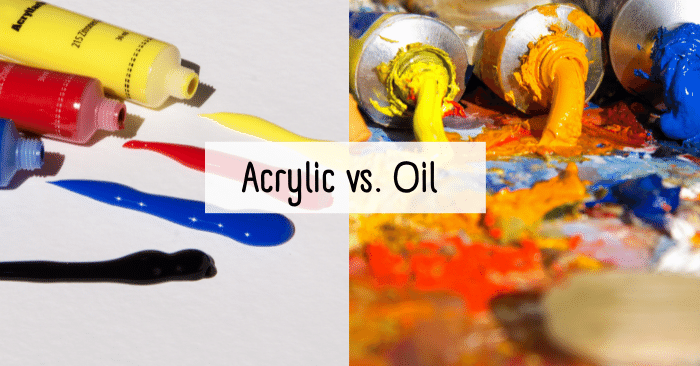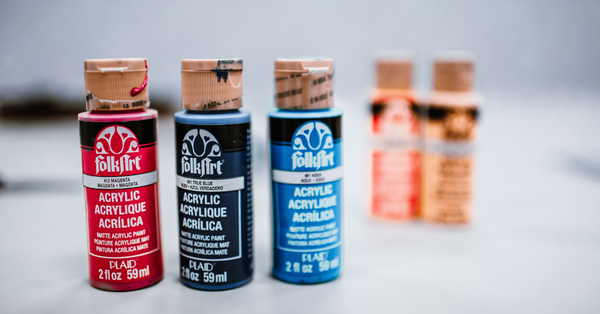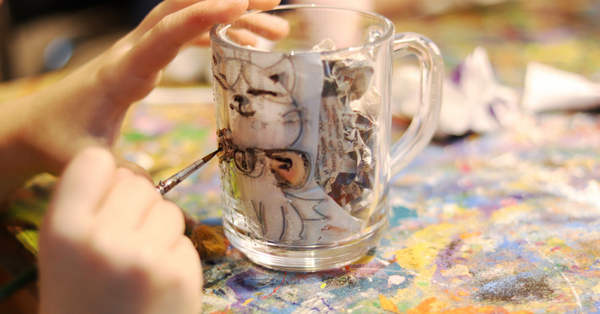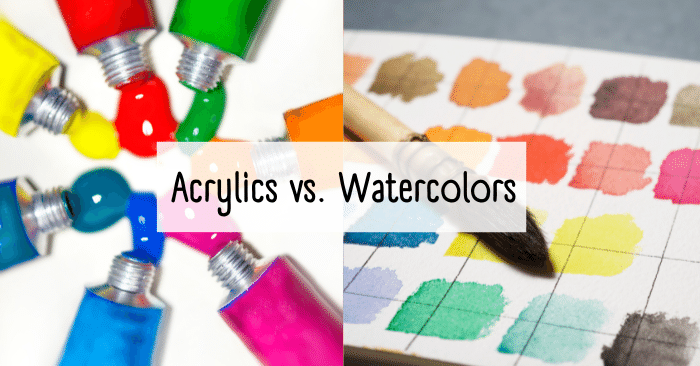
Choosing the type of paint you want to use for your next art project can be a bit overwhelming. While most artists can easily distinguish watercolors, it’s often more challenging to tell the difference between oils and acrylics, as the two are packaged similarly and can sometimes look alike in practice.
So, which one is better – oils or acrylics?
The truth is… neither! Each medium has its own benefits and unique qualities. Keep reading to learn the main differences between the two paints and which one is right for your next project.
TABLE OF CONTENTS
- What is Oil Paint?
- What Surfaces Can You Use Oil Paint On?
- Tips for Working With Oil Paints
- What is Acrylic Paint and How Is It Different to Oil Paint?
- What Surfaces Can You Use Acrylic Paint On?
- Tips for Working With Acrylic Paints
- Oil vs Acrylic Paint – Which Is the Better Option for You?
What is Oil Paint?
The consistency and texture of oil paints is what sets them apart from other art mediums. These paints are created with an oil base, binding agents, and color pigments, making them very thick and oily. They are typically created with a natural oil, like linseed or safflower. Oil paint can also last for hundreds of years.

However, despite their natural roots, oil paints should be used in tandem with a paint medium in order to make them more workable. Unfortunately, most oil paint mediums are highly toxic, so extra care should be taken to avoid injury or illness. These products can also emit unpleasant, flammable fumes. Because of this, cleaning up after using oil paints should be taken very seriously as it can be harmful to people and the environment.
What Surfaces Can You Use Oil Paint On?
Oil paint is most commonly used on thicker surfaces, like canvas, wood, metal, and ceramic. They tend to produce a smooth, creamy consistency. Since these paints are oil-based, they stay wet longer and take extra time to dry. This makes them great for artists who really like to take their time and focus on the miniscule details.

Because oil paints have more pigments in them, the finishing colors are more vibrant and rich. In addition to the vibrant colors they produce, oil paints also create some great textures. They blend together seamlessly since they stay moist throughout the painting process. But, if you’re looking for clean, crisp lines, you might want to explore another medium for your project.
In sum, oil paints are timeless and can be used to create beautiful, vibrant paintings with seamless blending and interesting textures. If you are cautious and deliberate when painting and willing to put in the extra work for safety and clean-up, oils might be the way to go.
Tips for Working With Oil Paints
Ready to test out your oil painting skills? Follow these tips for a smooth and safe introduction to this classic medium:
- Fat Over Lean – When applying a medium to your oil paints, either to thin or thicken the consistency, be sure to start with lean mixtures (thinner) and finish with fat mixtures (thicker). This will ensure the top layers of paint are drying slower than the bottom layers, which will reduce the chance of cracking as it dries.
- Prep Your Canvas – In order to prevent paint from soaking through a canvas and deteriorating it, you must prime your surface. Some canvases come pre-primed, but these can be more expensive. So, if you’ve opted for the cheaper, unprimed option, be sure to take a few extra steps to achieve an optimal finished product. Start by sizing it (animal glue is commonly used for this step) to seal and protect the canvas. Then, apply a ground layer to create a uniform texture, color, and absorbency level. Gesso is the most common ground used for oil paintings – it’s a combination of oil, inert white pigment (chalk, whiting or plaster of Paris), and an aqueous binder.
- Limit Your Color Palette – Since oils blend so well together, limiting your color palette can make your painting more harmonious and less chaotic. It will help tie all the various elements together and force you to focus on technique, texture, and detail.
- Try Scraping Paint Off – It’s tempting to keep adding layers and layers of oil paint to obtain a certain finished look. However, oil paintings benefit tremendously from intentional scraping, either by using a palette knife or the blunt end of your paintbrush. You can achieve a wide range of textures and details by applying this technique.
If you’re new to oil painting, the Grumbacher Academy Oil Paint set includes 10 colors and is great for a beginner while also offering high-quality, professional results.
What is Acrylic Paint and How is It Different to Oil Paint?
On the other hand, acrylic paints are water-based rather than oil-based and will become water-resistant when dried. They’re made from pigment suspended in acrylic polymer emulsion and plasticizers, silicone oils, defoamers, stabilizers, or metal soaps. They dry much quicker than oils do, and they don’t require any mediums to use – just water will do.

Acrylics have become an extremely popular medium because of their fast-drying qualities, low toxicity, and ease of use. While beneficial from an efficiency standpoint, drying too quickly can be problematic for artists who are working to carefully add in subtle details as their piece progresses.
Also, acrylic paints do not require toxic mediums to use, making them a safer option for artists and eliminating unpleasant odors. That said, acrylics still contain plastics which are harmful to the environment when not disposed of properly. So, you should still be cautious when using them!
What Surfaces Can You Use Acrylic Paint On?
Acrylic paints are suitable for a wide range of surfaces including canvas, paper, wood, glass, and ceramic. They’re great for almost every type of painting or crafting project. Be aware, though, that some colors will dry slightly darker than they first appeared on the canvas.

Since acrylic dries quicker, it can also be more challenging to blend colors as you work, unless you keep a spray bottle filled with water nearby. In terms of texture, acrylics offer a crisper finish than oils and therefore require different techniques to achieve certain textures.
Ultimately, acrylic paints offer an efficient, seamless, and safe experience for artists without compromising quality. They can be used for a wide range of projects and are easy to incorporate into your portfolio of mediums.
Tips for Working With Acrylic Paints
Interested in taking a stab at painting with acrylics? Follow these tips for best results:
- Work Efficiently – Unlike oils, acrylics dry quickly. You’ll want to work in one area at a time and avoid repainting the same area too many times. Always go into an acrylic piece with your end goal in mind to speed up the painting process. Since acrylics are water-based, however, you should be able to retain some flexibility by applying more water as needed. That is, until your acrylics have completely dried of course.
- Clean Your Brushes After Each Use – Acrylic paint is very easy to clean off of your brushes; however, if you allow it to dry and harden, it becomes nearly impossible to remove completely. So, get in the habit of cleaning your brushes immediately after each use. It will save you time and money in the long run.
- Use Synthetic Paint Brushes – Synthetic brushes are best for acrylic paint because they’re durable and resistant enough to withstand the chemicals in acrylic paint. Plus, they aren’t too stiff or too soft, making them ideal for painting with acrylics.
If you’re interested in working with acrylics but don’t know where to start, we recommend the Arteza Acrylic Paint set which comes with 24 different colors at 22 ml.
Oils vs. Acrylics – Which is the Better Option for You?
While neither option is ‘better’ than the other, there are certain things to consider when selecting a paint type for your next project. Ask yourself the following questions to determine if oil or acrylic paint is right for you.
Does this painting require a significant amount of detailed work?
If you expect to spend a lot of time painting tiny details, you should really consider oil paints. With oils, you can really take your time with the piece and not worry about the paint drying too quickly.
Will you be painting around kids or pets? Will you be working in a tight space with little ventilation?
If you answered yes to either of these questions, acrylics might be the way to go. Oil paint can be very toxic and safety should always come first.
Is cost a driving factor?
If cost is a concern, acrylic paint might be the more viable option for you as it is less expensive than oil paint and doesn’t require additional mediums.
Key Takeaway
Ultimately, both mediums are great for specific projects and situations. It’s best to be well-versed in both, as these are two of the most popular paint materials for a reason. But, use your best judgment and have fun exploring new techniques and painting methods!



